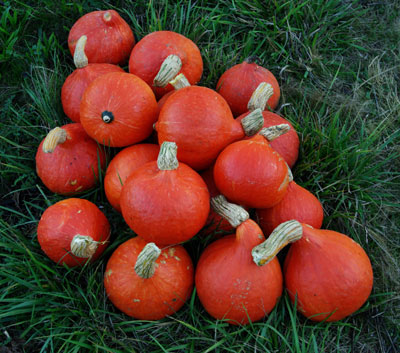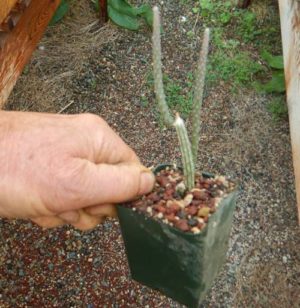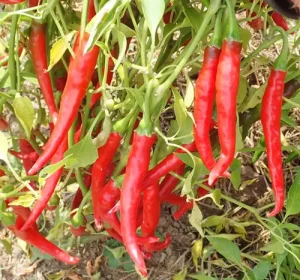Squash, Red Kuri (Cucurbita maxima), packet of 10 Seeds, Organic
$2.95
Annual. 100 days to maturity
(Japanese Red Kuri Squash, Hokkaido Squash, Baby Red Hubbard, Uchiki Kuri)
Native to Mesoamarica and grown worldwide. We found this squash to be gratifyingly vigorous and pest resistant, and it gave more food value per square foot than just about anything else we grew in the garden. The flea beetles did go after the seedlings right when the ground warmed up in the early summer, but we spread some neem seed meal around the plants and on the young leaves and this saved them. I think some of the seedlings would have made it through without treatment, but I was already salivating, so didn’t push my luck. The plants doubled in size every day or two. It was amazing to watch them grow. Good compost, I guess (thanks to Kalesh). Each vine bore 3 (more or less) bright globular fruits, and since we saved three plants per hill, that gave 9 squashes per hill, which was a lot. But it was not too many–we ate them all! This is our favorite squash. We like to split it, scoop out the insides (which is really easy to do, given the shape) and bake the halves in the oven until done. As the squash cooks, it creates its own sugary glaze. We find it unnecessary to augment the natural nuttiness and sweetness with any oily or sugary additive. We like to eat these as they are, but we also like to make them into pumpkin pies. We think they make the best of all pumpkin pies, not only because they are particularly tasty, but because the flesh is dry, meaty, and stringless, and reconstitutes admirably well inside a pie shell. (Too much water in squash used to make pumpkin pies is a real no no.) Standard vegetable culture. Prepare a rich hill and direct seed 5 seeds per hill, then thin to the best 3 seedlings. Allow the plants to sprangle. Give them plenty of room–they will extend at least 5 feet in every direction, unless you train them to do otherwise, which by the way can be done. Water deeply twice a week. We found that our’s were harvestable before frost and didn’t need to be stored to develop sugar. But the standard method with squash is to harvest after the first light frost, wash with cold water and sun dry, then put into cool, dry storage. Another option is to go into a baking frenzy and bake the fruits and then smash the clean flesh into freezer containers and freeze for later use. We like to freeze them in 3 cup baggies, just enough to make 2 pumpkin pies, or augment a winter dinner.
10 seeds/pkt, Certified Organically Grown
In stock






lists –
Mike, I let mine grow up a 6′ chain link fence when I lived in Colorado, and the plants loved it. They would have happily grown taller, and did grow to cover most of the fence. I just planted them at the base and let them go, occasionally winding an end into the links, but mostly it did that itself. I had no problem with the squash being too heavy.
Upvote if this was helpful (0) Downvote if this was not helpful (0) Watch Unwatch Flag for removal
Question
Jaclyn (verified owner) –
These seeds are so eager to grow!!
It germinates in my little seed starter egg shell in 5 days, and continued its rapid growth in the ground sitting in a pile of homemade compost with worms. Now one month past, I have already seen a baby squash about 2″ in diameter, which comes from the first female flower seen, flowers exudes a light fragrance!
Question: Are the flowers edible?
Upvote if this was helpful (0) Downvote if this was not helpful (0) Watch Unwatch Flag for removal
Richo Cech –
Hi Jaclyn,
I do agree with you, we planted a long row of these in the spring and we needn’t have spaced them so closely–it did appear that every seed came up. Good going, I don’t know if you’ll have squash for thanksgiving but these do make the best pumpkin pies. Richo
Upvote if this was helpful (0) Downvote if this was not helpful (0) Flag for removal